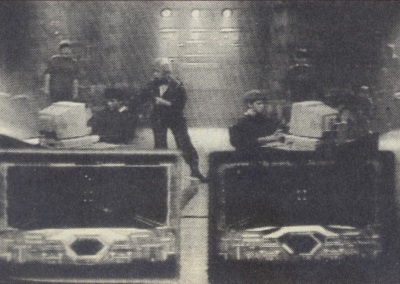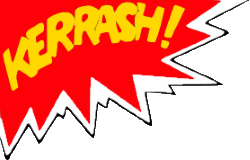NEWSFIELD PLANS NEW GAMES MAG
NEWSFIELD LTD, the publishers of CRASH, will launch a major new computer
magazine at the PCW Show in September — covering 16-bit machines like the Atari
ST and Amiga, games consoles, and the major 8-bit machines (including the
Spectrum).
THE GAMES MACHINE, a 116-page monthly costing £1.25, will join
CRASH and ZZAP! 64, the country’s best-selling machine-specific titles.
‘THE
GAMES MACHINE will offer readers the widest coverage of any home-computer mag,’
stressed Newsfield Director Franco Frey, ‘as well as the honest, fair
reviews which are the secret of CRASH and ZZAP!’s success. There’ll really be
no competition.
‘We’ve got access to some of the country’s most experienced
computer journalists, and they’ll pool their talents for THE GAMES MACHINE. Of
course, we’ll also be going ahead with some exciting projects we’ve got cooking
for CRASH and ZZAP!...’
A STAR IS BORN
RAINBIRD’S first CRASH Smash, Starglider, will be the first British computer
game to enter the arcades. Top coin-op manufacturer Bally/Sente has been
licensed to convert the 3-D space shoot-’em-up.
‘This is only the beginning,’
predicted Rainbird boss Paul Hibbard. ‘Starglider has broken the barrier of
computer conversions to coin-op games.’
And ‘it’s always been my dream to have
one of my games in the arcades’, says programmer Jez San.
Not satisfied with this fame and fortune, Starglider (released Christmas) is also appearing weekly on ITV’s popular
Saturday morning show Get Fresh.
The game stars in a nerve-racking team contest — from now till the end of August, competitors must blast away to save friends from
getting sludged in front of 4.8 million viewers.

Going places: Rainbird’s Starglider features on ITV’s Get Fresh
THAT’S ENOUGH HAMSTERS — ED

Attack of the mutant contrived photo opportunities: CRL’s Ninja Hamster game
BEHIND every great hamster there’s a turtle. At least, that’s what CRL found
with their new name-’em-up Ninja Hamster, scheduled for release at the end of
June.
The man behind the turtle was Ian Ellery, Creative Director at CRL when
Ninja Hamster was conceived (he’s now at Nexus).
‘It actually started off as a
practical joke on Your Sinclair magazine,’ admits Ian. ‘We just made up a load
of things we were releasing, and Ninja Hamster stuck. I was only doodling...’
And behind the doodles, of course, was the trendoshop of 1987 —
your local comics outlet. ‘It was making fun of the comic Teenage Mutant
Ninja Turtles,’ recalls Ian. ‘I was in the shop and everyone else was making
fun of ninja comics, so I decided ‘why not’?’
The
black-belted warrior of CRL’s new game (programmed by Colin Ajayi ’Obe)
battles with eight opponents, including Sinister Rat and The Lizard Of Death,
in a struggle to keep his village safe for decent rodents to live quiet lives.
According to Mike Hodges in the software house’s ‘Zen room’, where men are men
and hamsters are gerbils, ‘it’s an ordinary karate game with a hamster’...
which kind of says it all.
WORLD ENDS

Martech boss David Martin gives Reagan a POKE for The Armageddon Man
IT’S nukes
with everything in two apocalyptic new games — Activision’s High Frontier and Martech’s The Armageddon Man.
High Frontier, rather quietly proclaimed as ‘one of the most controversial pieces of software
yet’, puts you in charge of the American Strategic Defence Initiative
(President Reagan’s proposed Star Wars system, which would use weapons in orbit
to wipe out nuclear attacks).
Written by Alan Steel, coauthor of the grittily
realistic Theatre Europe, it’ll be out in July for £7.95.
Also in July comes The
Armageddon Man (£12.95), a peacegame set in the year 2032. As the eponymous
controller of an omniscient satellite, the player has to keep 16 superpowers
happy and avoid war by preserving a balance of power.
PLUS WHAT?
SPRING came late to the Spectrum this year; the ‘spring’ Microfair didn’t
arrive till the penultimate day of May. Ardent micromaniacs ignored the
sunshine and crowded into London’s (not very) New Horticultural Hall,
seeking out the latest in Spectrum and QL goodies.
The Spectrum +3, with a
built-in disk drive, made an appearance on several stands, though manufacturers Amstrad didn’t turn up themselves.
But all the +3s at the show were
development prototypes. The new beast isn’t expected in the shops before
mid-July, and the user manual hadn’t been printed in time for the fair.
It
comes in a black box, like the +2 launched last autumn. The cassette unit is
replaced with a three-inch disk drive, as used on other Amstrad computers, Tatung’s Einstein, and very little else.
Each side of a plastic-cased +3 disk
holds almost 180K of programs or data, in the format used by drive A of
Amstrad’s PCW-8256 glass typewriter.
The software to control the drive is held
in an extra 32K of ROM. The disk system, written by Locomotive Software, is
derived from that of earlier Amstrads, though you can access it with the
standard ZX BASIC commands that used to refer to the cassette.
The other 32K
of ROM Is similar to that of the +2, though hackers will be pleased to find
that the NMI bug has been fixed. The +3 is NOT compatible with Interface 1 or
Microdrives.
The audio and video outputs mimic those of the +2. The
audio socket is also used to load and save cassette files, and the video
connector is now labelled ‘Peritel’; many new TVs have ‘Peritel’ inputs. The same
socket supports colour and black-and-white monitors.
Telephone sockets are
still used for the MIDI/Serial port and the nonexistent keypad, now labelled
‘Aux’. There’s a reset switch, but you still have to control the power at the
mains, as there’s no on/off switch.
The joystick sockets have scrambled
connections, as on the Plus Two, so you’ll need an adaptor from Frel or Cheetah
before you can plug in a normal stick.

The first of the few: Ocean’s Cosmic
Wartoad is among six games packaged with the +3
The +3 is supplied with a ‘free’ SJS-1 joystick. This is compatible with
Amstrad’s scrambled socket wiring, but has little else to recommend it.
At long last there’s a
Centronics parallel printer port built in — this is easier to wire up and
compatible with more printers than the serial socket which earlier 128s had,
and may make the +3 suitable for simple word processing.
But there are two problems.
The old concentric nine-volt power slot has been replaced by a
five-pin DIN socket carrying power for the disk as well as the computer. The
new plug is bulky, and fits just three millimetres away from the
edge-connector. Many peripherals extend into this area, so it will be
impossible to plug them directly into the +3. Other add-ons have plastic
loops intended to trap the old power plug in place; you may have to remove
those to make room for the new plug.
And the +3 edge-connector also lacks a vital signal called ROMCS (ROM Chip Select). That signal is used by
press-button copiers such as Multiface 1 and the Mirage Microdriver to switch
in new ROM and RAM and allow ‘protected’ programs to be saved.
The +3 comes
with six games on disk: Supertest 1, Supertest 2, Cosmic Wartoad, N.O.M.A.D.,
Gift Of The Gods and Mailstrom, all from Ocean.
But it’ll be a while before
popular titles are available in the format, and you’ll probably have to pay
extra for the convenience of disk loading. Software houses haven’t responded
very positively to Alan Sugar’s suggestion that they supply games for the
machine in groups of four titles for £10!
Publishers could cut their
overheads by providing Amstrad CPC and Spectrum games on the same disk, but
it’s unlikely that many will publish material on disk till tens of thousands
of machines have been sold. In the meantime, compatibility with tapes for
the original Spectrum and earlier versions of the 128 should be good. The
hardware includes two ‘lock bits’ to make the machine impersonate a 48K
Spectrum or a +2.
And there’s another way of getting cheap disk software for
the +3. At long last, the new hardware lets the Spectrum run as a 64K RAM
machine, with the screen display held in a switched page. This setup will
support the old business operating system CP/M, from Locomotive Software — conversion work is almost complete.
The machine will sell for £249, but trade
rumour has it that Amstrad intends to cut it to around £200 by Christmas. The
company refuses to comment.
SIMON N GOODWIN




